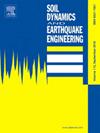Hybrid empirical ground-motion model for the Alborz region of northern Iran
IF 4.2
2区 工程技术
Q1 ENGINEERING, GEOLOGICAL
引用次数: 0
Abstract
The Alborz region is situated in northern Iran and is a seismically active region that has experienced several devastating earthquakes. Due to the scarcity of recorded data, only a few Ground Motion Models (GMMs) have been developed explicitly for the Alborz region, and most of the previous GMMs for Iran have been developed for the entire country by combining data from all five seismotectonic provinces. The capabilities of the Hybrid Empirical Method (HEM) in developing GMMs for regions with sparse recorded datasets enable us to develop a new GMM for the Alborz region. In this study, using the HEM approach, we developed a new GMM to predict Peak Ground Acceleration (PGA) and spectral accelerations (SAs) across periods ranging from 0.01 to 10 s in the Alborz region of northern Iran. The dataset comprises 775 acceleration records generated by 167 events, recorded at 309 stations within the range of 1 km < Rjb < 160 km and 3 < Mw < 7.4, from 1980 to 2020. We adopted a simple functional form that is a function of moment magnitudes (Mw) and Joyner-Boore distance (Rjb) for the reference site condition with VS30 = 760 m/s. This model is applicable for Mw in the range of 3–7.5, Rjb ≤ 200 km, and the reference site condition with VS30 = 760 m/s.
求助全文
约1分钟内获得全文
求助全文
来源期刊

Soil Dynamics and Earthquake Engineering
工程技术-地球科学综合
CiteScore
7.50
自引率
15.00%
发文量
446
审稿时长
8 months
期刊介绍:
The journal aims to encourage and enhance the role of mechanics and other disciplines as they relate to earthquake engineering by providing opportunities for the publication of the work of applied mathematicians, engineers and other applied scientists involved in solving problems closely related to the field of earthquake engineering and geotechnical earthquake engineering.
Emphasis is placed on new concepts and techniques, but case histories will also be published if they enhance the presentation and understanding of new technical concepts.
 求助内容:
求助内容: 应助结果提醒方式:
应助结果提醒方式:


